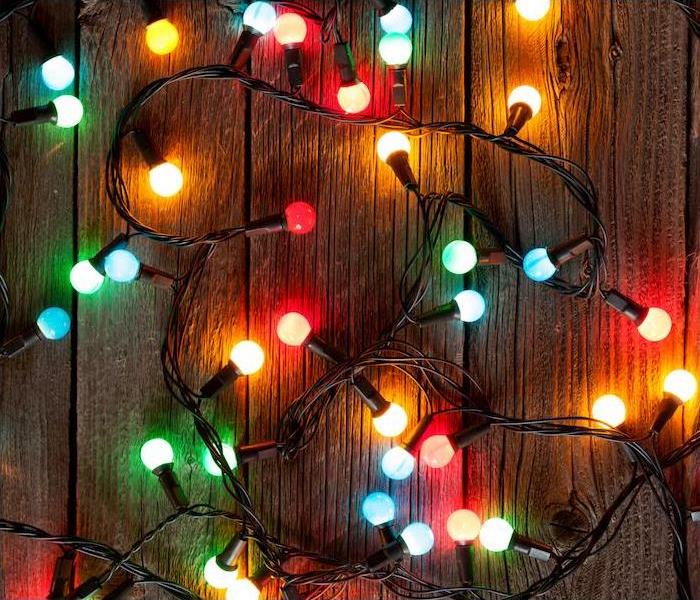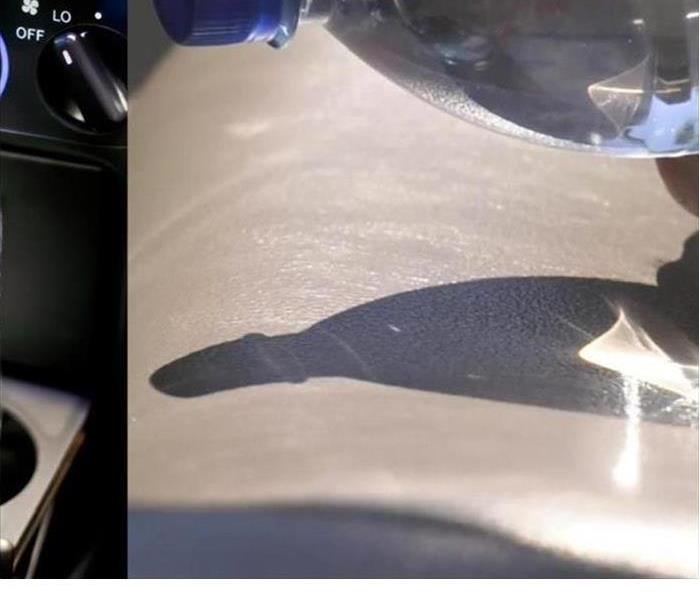Recent Fire Damage Posts
Safety First When Frying Turkeys During the Holidays
11/29/2021 (Permalink)
Each year, many people are severely burned and their homes are damaged from fires caused by frying turkeys for Thanksgiving and Christmas. Here are some safety tips from Elizabeth Ardness, University of Georgia College of Agricultural and Environmental Services found on www.georgiahealthnews.com.
Many times accidents are caused by misused equipment and overfilling.
1. Misused equipment: unstable fryer stands
2. Uninsulated pot handles
3. Fry Pots Overfilled with oil
To prevent overfilling, drop the turkey in the pot before marinating. Add enough water to cover 2" above the turkey. Remove the turkey and mark the water level. Once you have dried the pot, you can add oil to the waterline mark. Marinate your turkey and add back to the pot once the oil reaches 365-375 degrees Faranheight. This will take 45 minutes to an hour.
It is also important to kill all harmful bacteria. According to www.butterball.com, you must measure the temperature of the turkey in several places. Once the temperature has reached 180 degrees Fahrenheit at the thigh, and 170 degrees at the breast your turkey should be ready to enjoy!
Also, be sure that your frying area is at least 10 feet away from your home and on level ground.
Happy Holidays to you and yours!
What Do I Do After The Fire Truck Pulls Off???
8/24/2021 (Permalink)
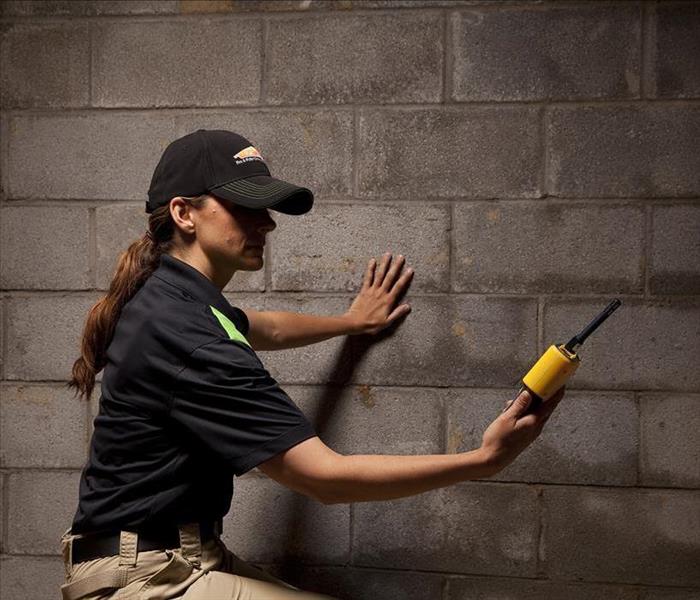 It's essential to hire a professional immediately after a fire loss in your home.
It's essential to hire a professional immediately after a fire loss in your home.
When a homeowner sees the fire truck leave their home after extinguishing a fire, it’s not uncommon for the owner to ask the question, What’s next? Since this kind of devastation can leave the owners' heads spinning, it may be difficult to make the wisest decisions, especially based on the knowledge that they have acquired over the years. Also, if this is the owners' first experience with dealing with a house fire, they may be confused and stunned. Fortunately, there are resources available that can assist a homeowner with getting through these hours with as few disruptions and discomfort as possible. By calling SERVPRO, a representative will arrive with the knowledge to provide the homeowners with a comprehensive plan to restore their property to its original preloss condition, "Like it never even happened."
Emergency Services – 24/7
Because a fire can occur in a home at any time of the day or night, it is important to be able to get the help that they need without any unnecessary delays. Once the fire truck leaves the property, the owner and their family must know how to respond to minimize this devastating situation. For instance, the windows and doors should be boarded up so that intruders cannot enter the home and cause additional damage or begin to take away items that were not damaged by the fire. This is why we offer emergency services to the owners that contact us, especially so we can help with taking the appropriate actions, while also devising a plan. Additionally, because no job is too small or too big, our technicians are trained in developing a customized plan to fit your situation.
Highly trained experienced professional restoration technicians
Even if a homeowner has dealt with fire damage in the home before, they can still use the help of a professional. This is because fire damage must be handled by trained experienced professionals that know how to restore the home to its pre-fire condition. For instance, when a fire occurs in the home, there are a wide variety of damages remaining. One of the most common involves extracting all of the water that the firefighters used to put out the fire as quickly as possible, specifically so that the family does not have to deal with secondary issues such as microbial growth. Another part of the clean-up process deals with smoke damage. While some areas of the home may not show any visible signs of fire damage, the smoke and soot from the fire can circulate to unaffected rooms. The SERVPRO fire & smoke remediation technicians, with IICRC and in-house training, use specialized equipment to remove the smoke from the carpeting, draperies, flooring, walls, ceilings, and other areas that have been affected. Ozone machines, air scrubbers, and several types of foggers help to limit this kind of smoke and soot damage.
When firefighters pull away from a home after a fire, the homeowner is tasked with the job of cleaning up and getting the home back to a pre-fire condition. To ensure the clean-up process is handled correctly, the owner will need to solicit help. Because our technicians are highly trained in fire restoration cleaning up services, we can assist you with doing a thorough job before occupying the home again. So, for help with fire damage in your home, contact SERVPRO of Statesboro at 912-754-9542.
Fire Damage Calls For Professional Help
8/24/2021 (Permalink)
Dealing with fire damage at any level can be stressful and disconcerting. Even a small amount of harm will disrupt your daily life, and most likely mean you’ll have to find somewhere else to stay temporarily while your home is restored to normal for safety reasons. It is good to know ahead of time of a reputable restoration company that you can call in a time of crisis, such as SERVPRO.
Fire damage never comes at a convenient time. However, understanding some things about the different steps of fire remediation is not difficult, and can help you to have peace of mind when tragedy strikes. At SERVPRO, we’ll take you through all the steps before even beginning any work, and explain questions you may have.
Loss from fire damage presents different challenges than regular repair and cleaning. The combination of the impact of intense heat, smoke residues, and water from firefighters creates an effect that will need various kinds of services from the fire restoration company.
Fire damage restoration services can be divided up into five categories.
Mitigation Services
The goal here is to secure your home and stop any more damage from occurring. Mitigation can include boarding up any openings and establishing a source of electricity that is temporary to your home. Structures that are wet from firefighting efforts will need emergency drying, so there is not any secondary water damage.
Structural Cleaning
When your home is damaged by fire, cleaning the structure will focus on getting rid of smoke residues from your home’s structural components and deodorizing odors which are given off by the residues. The adjuster and restorer will consult and advise you on which components can be cleaned and which ones will need to be replaced. All personal contents are not always salvageable after a robust fire damaging event.
Contents Cleaning
Your personal property has to be cleared from the smoke residues. In some situations with fire, your things can be cleaned right on site. Sometimes, however, contents will have to be packed up and moved to a different location for cleaning and storage. These situations happen if your home is not secure or if it is too damaged for on-site cleaning to be done.
Specialty Restoration
Content restorers from SERVPRO will at times subcontract specialty cleaning companies for particular contents such as dry cleaning of clothing, cleaning of electronics, refinishing furniture, and restoring expensive artwork.
Reconstruction Services
In some cases, structural components can be damaged so much that they can’t be restored to a preloss condition. Reconstructing and repairing fire-damaged structural components could need different skills than standard home remodeling. A fire damage restoration company like SERVPRO usually performs cleaning services while licensed general contractors perform highly extensive reconstruction services. SERVPRO can clear away the debris, eliminate odors as well as clean and wipe away soot "Like it never even happened."
Fire damage of any kind needs a professional touch. Call us at SERVPRO of Statesboro. when you have experienced a fire. We are available 24 hours a day, seven days a week at (912) 764-9542.
10 Ways To Avoid A Kitchen Fire
8/20/2021 (Permalink)
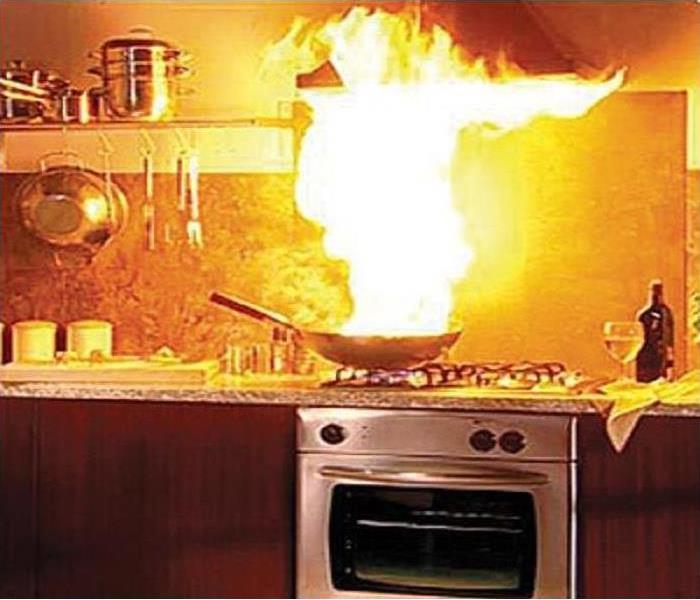 Stay safe in the kitchen!
Stay safe in the kitchen!
Did you know that the majority of house fires begin in the kitchen and the most common cause is cooking?
The American Red Cross has steps everyone can follow to avoid a cooking fire:
- Never leave cooking food unattended – stay in the kitchen when frying, grilling or broiling food. If you have to leave the kitchen, even for a second, turn off the stove.
- Check your food regularly while cooking and remain in the home while cooking.
- Use a timer so you’ll remember that the stove or oven is on.
- Don’t wear loose clothing or dangling sleeves while cooking.
- Keep the kids away from the cooking area. Enforce a “kid-free zone” and make them stay at least three feet away from the stove.
- Keep anything that can catch fire - pot holders, oven mitts, wooden utensils, paper or plastic bags, food packaging, and towels or curtains—away from your stove, oven or any other appliance in the kitchen that generates heat.
- Clean cooking surfaces on a regular basis to prevent grease buildup.
- Consider purchasing a fire extinguisher to keep in your kitchen. Contact your local fire department to take training on the proper use of extinguishers.
- Always check the kitchen before going to bed or leaving the home to make sure all stoves, ovens, and small appliances are turned off.
- Install a smoke alarm near your kitchen, on each level of your home, near sleeping areas, and inside and outside bedrooms if you sleep with doors closed. Use the test button to check it each month. Replace all batteries at least once a year.
Grilling Tips
8/20/2021 (Permalink)
Although the end of summer is coming up quickly, we still have lots of time to grill in South Georgia
SERVPRO of Statesboro would like to share some helpful grilling tips to prevent any fires from occurring while you're enjoying that quality time with family and friends.
Do:
1. Keep your grill at least 10 feet away from your home.
2. Clean your grill regularly.
3. Make sure to check for gas leaks.
4. Keep decorations away from the grill.
5. Keep a spray bottle of water handy.
6. Keep a fire extinguisher within a couple of steps of your grill.
DON'T:
1. Turn on the gas while your grill lid is closed.
2. Leave a grill unattended.
3. Overload your grill with food.
4. Use a grill indoors
Statesboro Area Smoke and Soot Cleanup
8/17/2021 (Permalink)
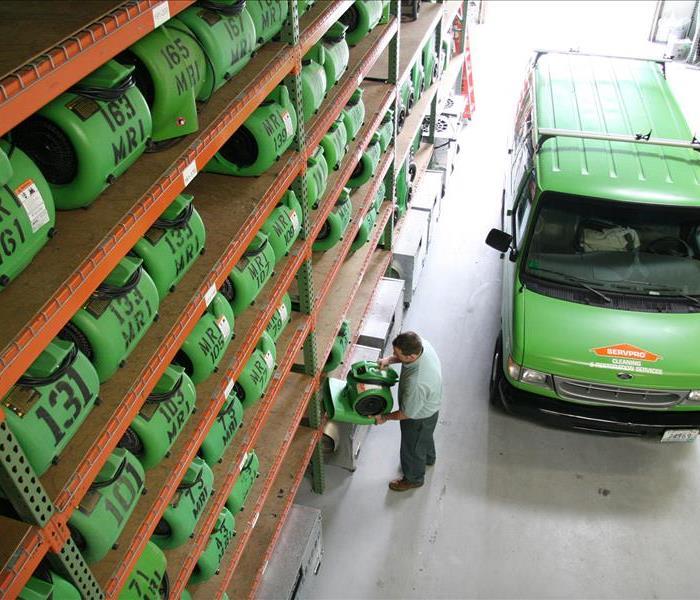 Smoke and Soot Damage Can Cause a Pervasive Odor in Your Statesboro Area Home.
Smoke and Soot Damage Can Cause a Pervasive Odor in Your Statesboro Area Home.
Smoke and soot is very invasive and can penetrate various cavities within your home, causing hidden damage and odor. Our smoke damage expertise and experience allows us to inspect and accurately assess the extent of the damage to develop a comprehensive plan of action.
Smoke and soot facts:
- Hot smoke migrates to cooler areas and upper levels of a structure.
- Smoke flows around plumbing systems, seeping through the holes used by pipes to go from floor to floor.
- The type of smoke may greatly affect the restoration process.
Different Types of Smoke
There are two different types of smoke–wet and dry. As a result, there are different types of soot residue after a fire. Before restoration begins, SERVPRO of Statesboro will test the soot to determine which type of smoke damage occurred. The cleaning procedures will then be based on the information identified during pretesting. Here is some additional information:
Wet Smoke – Plastic and Rubber
- Low heat, smoldering, pungent odor, sticky, smeary. Smoke webs are more difficult to clean.
Dry Smoke – Paper and Wood
- Fast burning, high temperatures, heat rises therefore smoke rises.
Protein Fire Residue – Produced by evaporation of material rather than from a fire
- Virtually invisible, discolors paints and varnishes, extreme pungent odor.
Our Fire Damage Restoration Services
Since each smoke and fire damage situation is a little different, each one requires a unique solution tailored for the specific conditions. We have the equipment, expertise, and experience to restore your fire and smoke damage. We will also treat your family with empathy and respect and your property with care.
Have Questions about Fire, Smoke, or Soot Damage?
Call Us Today – (912) 764-9542
Make sure your fire risk is low during the holidays. If you experience any damage, SERVPRO of Statesboro will be here to help.
11/23/2020 (Permalink)
Keep House Fires Out of Your Winter Celebrations | SERVPRO® of Statesboro
Though fire safety is an important focus at any time of year, as the chill of winter sets in, it is an even more pressing concern. The Red Cross has found that winter is when the most fires occur in the home, which is understandable given that many winter and holiday activities provide an ideal environment for house fires to start.
At any time of the year, cooking is the leading cause of household fires, and winter is no exception with more people trying new recipes and baking projects. In addition to this, heating and electrical fires become more of a concern with the use of heaters and decorations, so it is important to be aware of the risks and ideal prevention methods.
Preventing Fires Around the Winter Holidays
Keep safe when cooking. Cooking large meals or undertaking new baking experiments is a popular winter pastime, meaning that the chances for any type of cooking fire will increase accordingly. When cooking, it is important to never leave flammable objects near the stove, oven or slow cooker, and to never leave heating food unattended. It is also wise to keep a fire extinguisher on-hand in case any flare-ups do occur, so they can be addressed quickly.
Heat the house with proper precautions. As the winter chill sets in, reaching for space heaters or putting a fire in the fireplace is common, and can be done safely. It is important to note that space heaters should always be equipped with proper safety features and that fireplaces should never be left unattended, as these are some of the leading causes of winter fires. If you do have a fireplace, be sure your chimney is inspected every year to address any potential hazards.
Decorate with care. Most of us can appreciate fun, holiday decorations, but issues can develop with these electrical components that can be hazardous. Christmas tree fires are often caused by lights, mainly due to fraying of the wires or the overloading of outlets. Always check your strands of lights before using them, and never leave them plugged in when you will not be home or when you are going to bed.
If you have damage due to a house fire, you can depend on us to help. Contact us 24 hours a day to report damage and receive a quick response from our certified restoration technicians. Get in touch today.
Time to check those batteries!
4/16/2020 (Permalink)
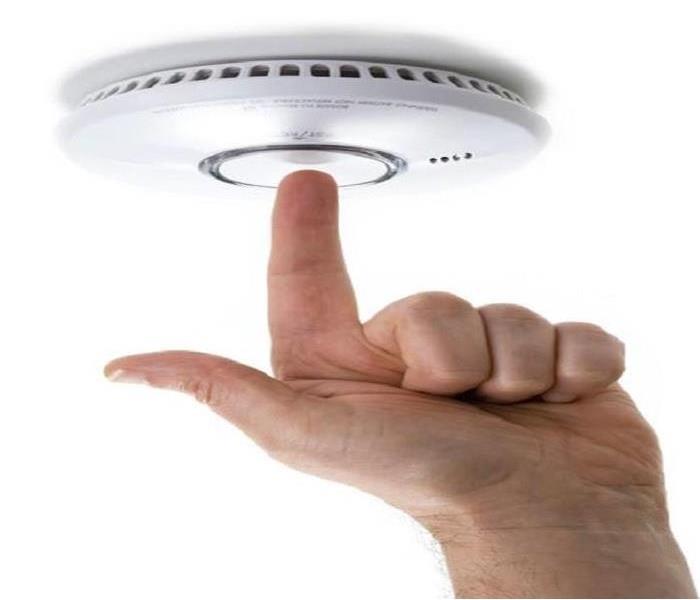 Maintaining your smoke detectors is how you'll be able to keep your family and home safe.
Maintaining your smoke detectors is how you'll be able to keep your family and home safe.
Spring is here and with everything going on in the world today a lot of us have forgotten a very important thing to check...our smoke detectors.
The U.S Fire Administration (USFA) states that smoke detectors should be checked monthly to ensure there are no malfunctions and that the batteries should be changed at least once or twice a year. Most people have found it easy to remember to do this when daylight savings time occurs. While you’re changing your clocks, go ahead and change your batteries in your smoke detectors.
Make sure you check your smoke detectors users manual and if any of the following apply, then you may need to check your smoke detectors more often:
- The detector gives a false alarm
- The alarm emits a short beeps regularly without anyone touching it
- Frequent kitchen smoke has caused it to activate often, which may cause the batteries to deplete quicker
There are two types of smoke detectors:
- Battery-Powered- This type can be susceptible to defective or worn-out batteries. Doing monthly testing is critical to ensure that the detector is working properly.
- Hardwired- This type is powered by your home’s electrical system, but are known to have backup batteries so the device can remain operational in a power outage. This type still requires a monthly test to help ensure that both the batteries and parts are working properly.
If your home isn’t equipped with smoke detectors, then please make sure you visit your local fire department. The fire departments in each community have access to fire safety equipment like smoke detectors and would be glad to make sure your family is safe.
Kitchen Fire
4/15/2020 (Permalink)
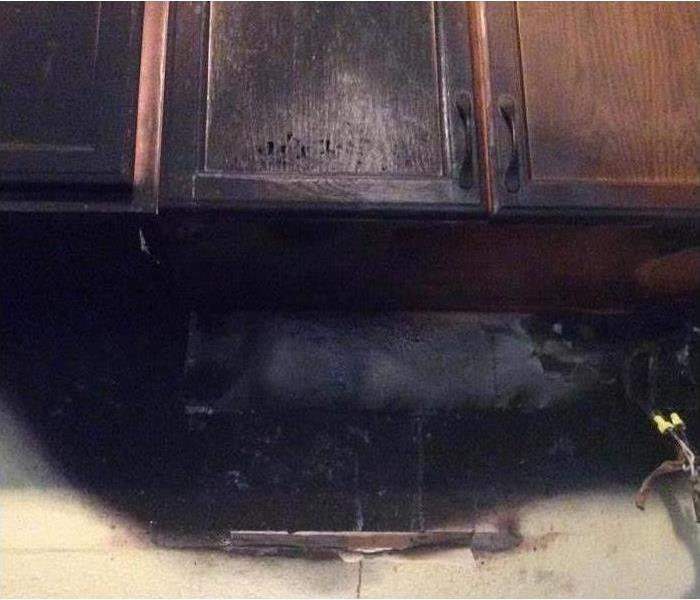 Kitchen catches fire damaging entire home.
Kitchen catches fire damaging entire home.
We received a phone call from a customer in regards to their kitchen catching fire and damaging the entire house. Soot and smoke touched every inch of the house. So how do we clean the soot from walls and contents?
One would think that we should be using water to wash away the soot. One would be wrong. Soot should not be cleaned up with water first. The water on a sponge or rag would just move the soot around on the material. Soot should initially be removed with dry sponges.
Dry soot cleaning sponges are used to remove soot and dirt where you don’t want the surface to get wet. It is made of a natural rubber and is used like an eraser. Once the surface of the sponge is dirty it has to be discarded. The sponges hold a remarkable amount of soot in the pours of the sponge.
After wiping the fine particles of soot off the surface the surface can be wet washed. This process needs to be done by a professional. If not done properly surface damage can occur.
There is a science to fire cleaning and you should trust and hire a professional if you have fire clean up that needs to occur.
This is why we love having IICRC certified technicians on our team! We work hard and have trained professionals ready to make it “Like it never even happened.”
Grilling Tips
4/15/2020 (Permalink)
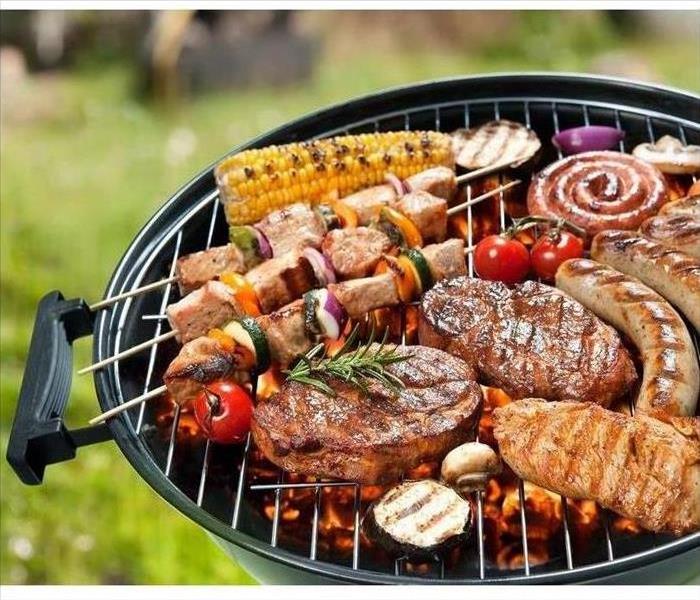 Time to pull out those grills!
Time to pull out those grills!
Spring has arrived and summer is upon us, which means it's time to pull out those grills.
SERVPRO of Statesboro would like to share some helpful grilling tips to prevent any fires from occurring while you're enjoying that quality time with family and friends.
Do:
1. Keep your grill at least 10 feet away from your home.
2. Clean your grill regularly.
3. Make sure to check for gas leaks.
4. Keep decorations away from the grill.
5. Keep a spray bottle of water handy.
6. Keep a fire extinguisher within a couple of steps of your grill.
DON'T:
1. Turn on the gas while your grill lid is closed.
2. Leave a grill unattended.
3. Overload your grill with food.
4. Use a grill indoors
Spot VS. Stain
4/15/2020 (Permalink)
After a fire, going through items can be extremely difficult. Part of that process is deciding if something is damaged beyond repair or needs cleaning. Here are a few ways to figure out if your items are stained or just covered in spots.
People often use the terms “spots” and “stains” interchangeably, but they have an important distinction between them. A spot is a visible surface discoloration that results from a soil that you CAN remove. A stain on the other hand, is a visible discoloration resulting from a color that permanently attaches that you CAN’T remove.
A skillful cleaner is sometimes able to turn what appears to be a stain into a spot. But someone with poor cleaning techniques may do the opposite. That’s why acquiring the proper spot cleaning knowledge, education and product that SERVPRO of Statesboro has to offer is crucial to carpet cleaning success. We offer a range of specialized cleaning methods backed by state-of-the-art equipment to insure your carpets or upholstery are spick and span, and spot and stain free.
Be sure to call SERVPRO of Statesboro at 912-764-9542.
Fire Safety Tips for Children
4/15/2020 (Permalink)
Children, especially younger ones, may not be capable of exiting a home on their own or understanding the dangers of fire hazards. If parents take the extra precautions not only by reducing risks in the home and installing proper safety equipment, but by creating and explaining a comprehensive fire safety plan of action with your family, the chance of risk can be greatly reduced.
Here are just a few fire safety tips for you and your family to get you started.
- The Stop, Drop and Roll technique – Stop moving, lie down and roll if clothing catches fire.
- Crawl through rooms and hallways to avoid smoke inhalation.
- Touch doors before opening – if the door is hot, don’t open it.
- Never re-enter the building for any reason once safely outside.
- Fire is a tool, not a toy.
- Never pick up matches or lighters if found. Instead, tell an adult right away.
- Never leave children unattended around any fire hazard, including cooking stoves, candles, portable heaters, or any other heat source. Teach toddlers and young kids to stay at least three feet away from any common heat source or hazard in your home.
Did you know, you can contact your local fire department for free fire safety equipment like smoke detectors? Some may even be willing to have your kids stop in for free fire safety tips. Make sure to check your community events, as some fire departments are known to have free fire safety classes for families.
You can also visit the link provided for more tips and activities for children.
http://keepkidsfiresafe.org/kids1.html
How to Avoid a Kitchen Fire- 10 Steps
4/12/2020 (Permalink)
 Never leave the stove or oven unattended.
Never leave the stove or oven unattended.
Did you know that the majority of house fires begin in the kitchen and the most common cause is cooking?
The American Red Cross has steps everyone can follow to avoid a cooking fire:
- Never leave cooking food unattended – stay in the kitchen when frying, grilling or broiling food. If you have to leave the kitchen, even for a second, turn off the stove.
- Check your food regularly while cooking and remain in the home while cooking.
- Use a timer so you’ll remember that the stove or oven is on.
- Don’t wear loose clothing or dangling sleeves while cooking.
- Keep the kids away from the cooking area. Enforce a “kid-free zone” and make them stay at least three feet away from the stove.
- Keep anything that can catch fire - pot holders, oven mitts, wooden utensils, paper or plastic bags, food packaging, and towels or curtains—away from your stove, oven or any other appliance in the kitchen that generates heat.
- Clean cooking surfaces on a regular basis to prevent grease buildup.
- Consider purchasing a fire extinguisher to keep in your kitchen. Contact your local fire department to take training on the proper use of extinguishers.
- Always check the kitchen before going to bed or leaving the home to make sure all stoves, ovens, and small appliances are turned off.
- Install a smoke alarm near your kitchen, on each level of your home, near sleeping areas, and inside and outside bedrooms if you sleep with doors closed. Use the test button to check it each month. Replace all batteries at least once a year.
Can leaving a water bottle in a hot car start a fire?
7/25/2019 (Permalink)
Can leaving a water bottle in a hot car start a fire?
If you are anything like me everything gets left in my car all the time, from bags, to shoes, even clothes; it’s a normal thing. We practically live in our cars, right? Well, the one item you should think twice about leaving in the car, especially when it’s hot, are water bottles. Now you’re probably thinking, what’s the harm in leaving a water bottle in the car? Well, I’ll tell you.
Plastic water bottles or glass reusable water bottles in your car are actually a fire hazard! Yes! A friend of mine recently found this out the hard way. She had actually had a wreck (everyone was fine, no bodily injuries. There was just some car damage.) and while sitting in the driver seat waiting on a tow truck she started to smell a "funny" smell in the car. She starts to investigate the "funny" smell and it turns out the bottle of water she’d left in the back seat was refracting light and causing the seat to catch on fire! As if the damage to the outside of her car wasn’t enough, she now had burn marks in her back seat! Hey, it could have been a lot worse. The whole car could have gone up in flames if it had gone unnoticed!
Incidents like these are pretty rare but it’s something we should be aware of. Firefighters have even issued a warning to drivers about hazardous water bottles.
A test was conducted by The Oklahoma Midwest City Fire Department on the matter and found that sunlight magnified by a water bottle can reach 250 degrees Fahrenheit. Firefighter David Richardson explained that the sunlight “uses the liquid and the clear material to develop a focused beam and sure enough, it can actually cause a fire, a combustion”.
Plastic water bottles can be even more dangerous because they leak harmful chemicals when left in heat. In a study investigating the effects of storage temperatures on the release of chemicals like antimony and bisphenol A, it was found that more chemicals were released as temperatures increased. The experiment also showed that when the water bottles were stored at 158 °F for 4 weeks, the release of bisphenol A and antimony didn’t meet regulation standards for chronic daily intake.
Bisphenol A, also known as BPA, is a chemical that has gotten some bad publicity over the years, and for good reason. It has been proven to alter hormone levels and is specifically linked with lower testosterone levels in men. BPA also contributes to cancer development and progression. Antimony, on the other hand, can cause stomach pain, vomiting, diarrhea, and stomach ulcers. It’s safe to say that ingesting large amounts of either of these chemicals isn’t good for anybody.
With this summer heatwave we have going on you’re probably going to be drinking a lot of water. Be cautious of the bottles you’re drinking from and where you leave them. Opt for the BPA free reusable bottles and take them with you – you’ll preserve your health, the environment, and your car that way!
Fire Safety Tips
2/27/2019 (Permalink)
The vast majority of which are home fires. The most common kitchen fire is from leaving something unattended. Depending on the materials in the kitchen, you could have only minutes to escape the danger.
Here are some fire safety tips:
- Install Smoke Alarms on every level of your home, inside bedrooms, and outside sleeping areas.
- Test Smoke Alarms every month.
- If you have children, talk with every family member about how to escape from their room. Have a safe place outside such as a tree in the yard, neighbor, or mailbox. Each member should go there immediately for parents to know that everyone made it out safely.
- If a Fire occurs in your home, GET OUT, STAY OUT and CALL FOR HELP.
SERVPRO of Statesboro has IICRC certified technicians on our team to help you through the aftermath of a fire.
Spring Cleaning and Check those Batteries
2/20/2019 (Permalink)
Spring is quickly approaching. The air is becoming warmer and the days are getting longer. We have already posted some Spring cleaning tips so hurry and read them before getting started! In addition to the deep clean that happens in your home, you need to check the batteries in your house. I am not talking about the remote batteries, but the smoke alarm batteries. Some smoke alarms may malfunction, and it may not alert you that the batteries are dying or dead. So during that Spring cleaning, you should always check and/or change the batteries in every single smoke alarm.
Every home should have multiple smoke alarms. One near the kitchen as this is a common place for a fire to break out in the house. A smoke alarm should also be on every level in the home- a basement, main floor, second floor, and even the attic. Why the attic? This is a place for an electrical fire to break out. In addition, no one monitors this place in the home so it is the perfect place for a fire to form and spread to the point where a homeowner cannot extinguish the fire.
Swainsboro Smoke and Soot Cleanup
8/31/2017 (Permalink)
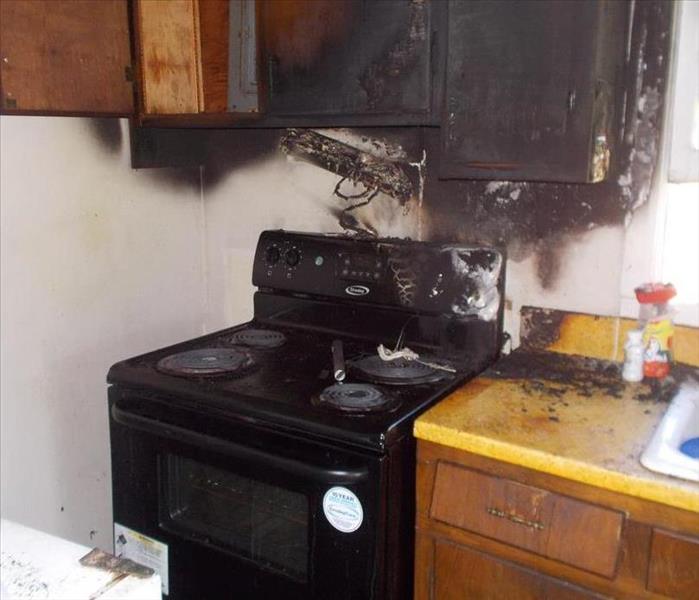 The Fire Took Place in the Kitchen but the smoke and soot could be found throughout other parts of the home.
The Fire Took Place in the Kitchen but the smoke and soot could be found throughout other parts of the home.
Smoke and soot is very invasive and can penetrate various cavities within your home, causing hidden damage and odor.
Our smoke damage expertise and experience allows us to inspect and accurately assess the extent of the damage to develop a comprehensive plan of action and make it look "Like it never even happened."
Smoke and soot facts:
- Hot smoke migrates to cooler areas and upper levels of a structure.
- Smoke flows around plumbing systems, seeping through the holes used by pipes to go from floor to floor.
- The type of smoke may greatly affect the restoration process.
Different Types of Smoke
There are two different types of smoke–wet and dry. As a result, there are different types of soot residue after a fire. Before restoration begins, SERVPRO of Statesboro will test the soot to determine which type of smoke damage occurred. The cleaning procedures will then be based on the information identified during pretesting. Here is some additional information:
Wet Smoke – Plastic and Rubber
- Low heat, smoldering, pungent odor, sticky, smeary. Smoke webs are more difficult to clean.
Dry Smoke – Paper and Wood
- Fast burning, high temperatures, heat rises therefore smoke rises.
Protein Fire Residue – Produced by evaporation of material rather than from a fire
- Virtually invisible, discolors paints and varnishes, extreme pungent odor.
Our Fire Damage Restoration Services
Since each smoke and fire damage situation is a little different, each one requires a unique solution tailored for the specific conditions. We have the equipment, expertise, and experience to restore your fire and smoke damage. We will also treat your family with empathy and respect and your property with care.
Fireworks Safety for the 4th of July
6/30/2016 (Permalink)
The number of Americans planning to use backyard fireworks this Fourth of July is expected to hit an all-time high. In preparation for holiday celebrations, The National Council on Fireworks Safety (NCFS) encourages consumers to review all safety tips before purchasing and using fireworks.
"Every year, safety is our first priority as families begin to plan their Fourth of July festivities. While fireworks are the most iconic and festive way to celebrate our country’s independence, there can be dangers if fireworks are used improperly,” said Nancy Blogin, President of the National Council on Fireworks Safety. “Consumers should purchase fireworks from a reputable company or fireworks stand, check local and state laws for fireworks use in your city, and check all instructions on fireworks packaging before use.”
The fireworks industry has made great progress in improving firework quality and reducing injuries; however, there is still work to be done as the vast majority of fireworks-related injuries in the U.S. each year result from the misuse of fireworks.
We have seen an increase in injuries among youth that have used fireworks in videos unsafely to impress their friends or to get a laugh. We want parents to help us put a stop to using fireworks in viral videos by encouraging safety and by explaining that the improper use of fireworks can produce serious injuries or even death.
“We have a collective responsibility as a community to put a stop to improper fireworks usage. If you see something that is unsafe, say something or report it to your local fire or police department,” said Blogin.
The NCFS’s mission is to educate the public on the safe use of fireworks and encourages consumers to follow the following safety tips before engaging in fireworks celebrations this Fourth of July:
1. Obey all local laws regarding the use of fireworks.
2. Know your fireworks; read the cautionary labels and performance descriptions before igniting.
3. A responsible adult should supervise all firework activities. Never give fireworks to children.
4. Alcohol and fireworks do not mix. Save your alcohol for after the show.
5. Wear safety glasses when shooting fireworks.
6. Light one firework at a time and then quickly move away.
7. Do not hold a fireworks item in your hand.
8. Use fireworks outdoors in a clear area; away from buildings and vehicles.
9. Never relight a “dud” firework. Wait 20 minutes and then soak it in a bucket of water before you discard it.
10. After purchasing fireworks, always store them in a cool, dry place.
11. When using fireworks always have a connected hose, bucket of water, or other water source nearby.
12. Never carry fireworks in your pocket or shoot them into metal or glass containers.
13. Do not experiment with homemade fireworks.
14. Dispose of spent fireworks by wetting them down and place in a metal trashcan away from any building or combustible materials until the next day.
15. Ensure all pets and animals are away from fireworks noise.
16. With the rise in stress-related disorders affecting American service men and women, pay special consideration to individuals who may be sensitive to loud noises in proximity to your fireworks show.
If you have any questions regarding how to properly use fireworks we encourage you to consult your local dealer.
About The National Council on Fireworks SafetyThe National Council on Fireworks Safety is a nonprofit 501(c) organization dedicated to educating the public about the safe and responsible enjoyment of consumer fireworks. For more information, visit http://www.fireworkssafety.org.


 24/7 Emergency Service
24/7 Emergency Service



